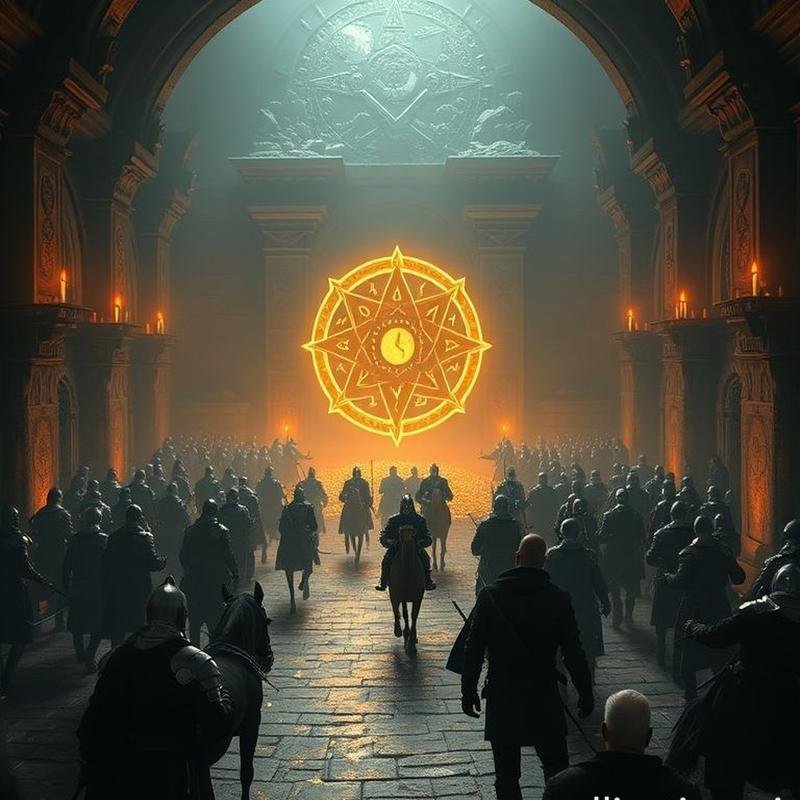The Knights Templar: Guardians of the Grail or the First Bankers? ⚔️🏦 A Shocking End.

Knights Templar: Guardians, Bankers, and Their Fall
Did you know that these warriors, sworn to protect pilgrims, were also pioneers of a global financial system, predating modern banks by centuries? This captivating documentary unveils the hidden face of the Knights Templar, a face long obscured by legends, and reveals how their immense financial power became a curse that ultimately led to their devastating downfall.
Before we delve deeper into the compelling evidence, share your expectations regarding this lesser-known aspect of the Knights in the comments section. And to join us on this journey to uncover astonishing truths, please subscribe to the channel.
The Genesis of the Knights Templar
In the late 11th century, Europe was swept by religious fervor, igniting the First Crusade in response to Pope Urban II’s call. In 1099, Jerusalem fell to the Crusaders, resulting in a notorious and brutal massacre. Amidst this widespread chaos, a unique organization emerged.
In 1119, in Jerusalem, Hugues de Payens and Godfrey de Saint-Omer founded the Knights Templar, initially with only nine knights. Their ostensible mission was to protect the throngs of European pilgrims who journeyed to the Holy Land, a perilous undertaking given the treacherous roads and the ever-present threat of robbers and bandits preying on defenseless travelers.
However, they soon transcended their role as mere protectors. In 1129, they gained official recognition and support from the Catholic Church, and through the influence of Bernard of Clairvaux, they acquired considerable influence and wealth through generous donations and land grants from nobles. Bernard’s support was pivotal; his advocacy and esteemed spiritual standing transformed the Knights from humble protectors into a formidable force.
The Templars as Financial Pioneers
However, what remained largely unknown was that these devout warriors were laying the groundwork for an unprecedented financial revolution. By the 12th century, their network had expanded extensively across Europe and the Middle East, serving not only as military communication lines but also as crucial financial arteries.
Imagine a pilgrim carrying a bag laden with gold, a journey fraught with risk. The Knights Templar offered an innovative solution: rudimentary letters of credit. A deposit could be made in London and safely withdrawn in Jerusalem. This simple yet groundbreaking technique reduced risks and provided security.
Their headquarters in Paris became a de facto royal treasury. Even monarchs, including Philip of France, deposited their treasures and funds under the protection of these knights. In return for their services, they levied fees, which fueled their burgeoning wealth, estimated to exceed that of entire European kingdoms.
Hugues de Payens, their first Grand Master, was not only a military leader but also the architect of this financial empire. He leveraged his noble connections to secure financial support and establish the Knights Templar as a formidable economic power.
A Transcontinental Financial Network
During the Middle Ages, the Knights Templar were not just holy warriors but also the masterminds of a transcontinental financial network, its reach extending from London to Jerusalem. Their castles served not only as impregnable fortresses but also as branches of a medieval bank, managing vast amounts of wealth.
Envision a sprawling real estate network, encompassing imposing castles, fertile agricultural lands, and thriving commercial properties in urban centers. Each holding generated substantial revenue, and each castle served as a vital administrative center. They safeguarded not only the legendary Holy Grail but also the wealth of kings and nobles, managing their assets as trusted custodians.
They pioneered a system of financial transfers that was revolutionary for its time. A pilgrim could securely deposit funds in London and easily withdraw them in Jerusalem, mitigating the dangers posed by highwaymen and robbers. This system was a lifeline for trade and tourism, and their network of hospices, strategically located along pilgrimage routes, served as thriving commercial hubs.
However, their ambitions extended further. They provided loans with interest to kings and emperors, becoming an influential force in European politics. Philip IV of France, for example, owed them substantial sums, a debt that would ultimately prove costly. Their naval fleet, traversing the Mediterranean, transported not only soldiers but also valuable goods and commodities, further enhancing their economic power and political influence.
The Seeds of Downfall
In 1285, Philip IV, known as the Fair, ascended the throne of France, an ambitious king determined to dominate Europe. However, these ambitions required vast resources, and his debts to the Knights Templar accumulated, foreshadowing an impending crisis.
The Knights Templar served as the treasurers of the French kingdom, its trusted bankers, and the secure repository for its funds. However, Philip’s costly wars, particularly in Flanders, exacerbated his dependence on them. By 1307, he owed them an astronomical sum, a debt that threatened his financial independence and made him beholden to the Templar’s growing power.
However, Philip was unwilling to be a mere puppet. He desperately sought alternative means to replenish his depleted treasury, often resorting to ruthless and unscrupulous measures. He devalued the currency and imposed heavy taxes on the clergy, provoking Pope Boniface VIII and igniting a bitter conflict between church and state. His marriage to Joan I, Queen of Navarre, brought him Champagne but also added to his mounting financial obligations. Philip was trapped by debt, desperate for a solution, and prepared to take drastic action.
The Black Friday Betrayal
Philip sought a way out of this predicament and found it in shocking accusations. At dawn on a Black Friday in 1307, France was stunned by royal orders to arrest all Knights Templar on charges of heresy and high treason.
Denial of Christ! Spitting on the cross! Secret demonic practices! Heinous accusations that shook the foundations of Christian society. How could war heroes, protectors of the Holy Land, suddenly be accused of devil worship?
The answer lies in the dark rooms and torture chambers. Under the unbearable duress of brutal torment, many Knights Templar succumbed and confessed to these heinous crimes. Confessions extracted by force were then presented as conclusive evidence of their guilt.
However, did these confessions reflect the truth, or were they merely desperate pleas from men under duress, seeking an end to their suffering?
Rumors persisted that Philip owed the Templars vast sums. Were these accusations merely a pretext to conceal his true motives: to eliminate his debts and eradicate a power that threatened his absolute authority?
In 1314, Jacques de Molay, the last Grand Master of the Knights Templar, stood before a large crowd. He recanted his previous confessions and bravely proclaimed his innocence and the innocence of his knights. However, his courageous words were ignored, and he was executed by burning.
The Final Chapter
The curtain falls on a bloody chapter in the history of the Knights Templar. On October 13, 1307, France launched a sudden and devastating series of arrests. Thousands of knights, including the order’s most prominent leaders, were imprisoned on fabricated charges of heresy and blasphemy.
These arrests marked not only the beginning of the end but also the prelude to grotesque sham trials, ostensibly aimed at uncovering the truth but secretly intended to destroy the Templars.
Torture, a vile weapon, was used extensively to extract forced confessions. The strappado, where victims were hoisted by their limbs until their joints were nearly dislocated, was just one tool in the arsenal of inhumane abuse. Burning with fire and continuous psychological pressure were also employed to break their will and crush their spirit.
Jacques de Molay, the last Grand Master of the Templars, was subjected to this systematic brutality. Under excruciating torture, he falsely confessed to denying Christ and spitting on the cross, a false confession that shook the order. However, De Molay soon recanted his confession, declaring his innocence and the innocence of his knights, but his courageous voice was lost amidst the vile conspiracies.
In 1310, the scenes were chilling. Fifty-four knights, who swore on their honor that their previous confessions were false, were burned alive at the stake in public. Their bodies were charred, their voices silenced by the flames, but their final silence spoke louder than any forced confession.
However, this was only the beginning of the end. The false accusations leveled against the Knights Templar, relentlessly promoted by King Philip, deeply damaged their reputation. This was more than just defamation; it was a prelude to a judicial massacre.
In 1312, Pope Clement V issued the papal bull Vox in excelso, officially dissolving the Knights Templar. The decree did not find conclusive evidence to convict the Knights Templar of heresy but acknowledged the scandal caused by the accusations against them. The Pope claimed that the dissolution was an act of apostolic wisdom, a decision taken to avoid further discord.
Two years later, in 1314, Paris was the scene of another tragedy. Jacques de Molay, the last Grand Master of the Knights Templar, was burned alive at the stake by order of King Philip IV. Amidst the raging flames, his curse echoed through history, directed at both the King and the Pope, foretelling their imminent demise.
The irony was swift. Within a year, both the King and the Pope died, further solidifying the legend surrounding the Knights. As for their possessions, they were officially transferred to the Knights Hospitaller under the papal bull Ad providam, although King Philip ensured that he retained the majority of their wealth in France. An era ended, but one cannot help but wonder if it was a just end.
Watch the Documentary








